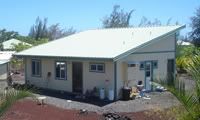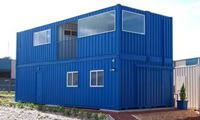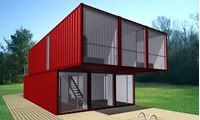Brief History of Shipping Container Housing Projects


The idea of making buildings out of old maritime shipping containers - those long, narrow steel boxes used to ship bulky items by sea and truck - is not new.
But a couple of Montreal-area companies are now offering prefabricated shipping container kits that promise to make building a home or business cheaper, faster and more environmentally friendly.
Over the past 15 years or so, green-minded architects and urban designers have been dreaming up creative new uses for the millions of used shipping containers that are taking up space in shipyards and dumps around the world.

Shipping container projects around the world include designer homes, a youth hostel in Amsterdam, a large-scale residential development in London called Container City and a travelling retail store. (The latter, designed by New York City architecture firm LOT-EK for the sportswear company Puma is an 11,000-square-foot retail outlet made of 24 refurbished containers.)
These watertight, durable, corrugated steel containers are great for transporting large items by ship and truck, but after a few decades their travelling days are over. Though some old containers are too damaged to pass inspection, many remain intact but companies find it cheaper to buy new containers than to ship empty ones back to their point of origin, which has lead to a surplus.

The containers are rust-proof, fireproof and mould-proof - measuring about 6 metres long and 2.5 metres in height and width - making them well-suited for re-use as buildings. And since they are so abundant, they are relatively cheap and easy to acquire.
Montreal entrepreneur Daniel Noiseux has just opened a mobile restaurant - a transformed and refurbished container - on the Quai des éclusiers in the Old Port. Noiseux calls his prototype the MuvBox, and is marketing the concept to entrepreneurs who like the idea of not being tied down permanently to any one location.
Except for an eye-pleasing paint job, the MuvBox looks like a shipping container when closed. But within minutes every morning, it is transformed into a small open-air diner, complete with tables on a terasse, awnings for shade and a fully functional kitchen. Solar panels on the roof provide 30 to 40 per cent of the energy needs.
It's all in the box, Noiseux says.
"We think of the MuvBox as a boat that you can anchor anywhere, that is totally self-contained and self-sufficient, and when it leaves a place, there is no trace of its presence left behind," said Noiseux, who also owns the Pizzaiolle restaurant chain.
Although his first prototype is a restaurant, Noiseux said he can tailor the concept to a client's needs. The MuvBox could be a travelling retail outlet, bistro or demonstration unit. The base price of a MuvBox, which includes transformation of the container, lighting, flooring, and exterior design, is $150,000.
And in Ste. Adèle, a company called Idekit Homes is offering to turn one or more shipping containers into fully insulated, functional homes or home extensions at a cost of about $100 per square foot.
Jocelyne Labelle and her partner Bernard Morin completed and moved into their first prototype of an Idekit home in 2007. The three-bedroom, 3,000 square-foot home is made from seven shipping containers. The steel containers' corrugated steel walls are covered with soy-based urethane insulation, and finished in wood.













0 comments
Post a Comment